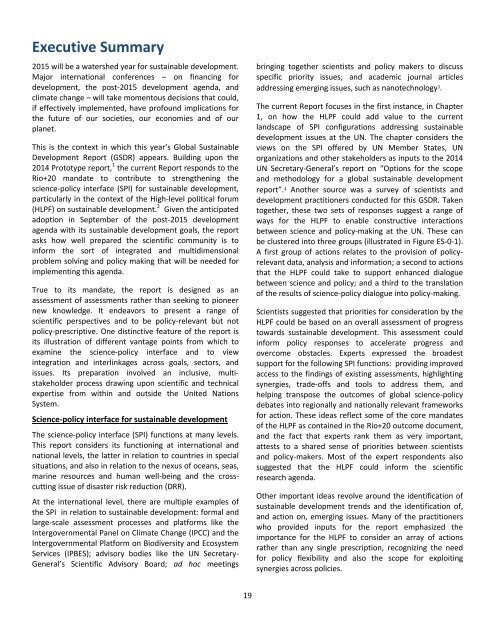1HlG51J
1HlG51J
1HlG51J
Create successful ePaper yourself
Turn your PDF publications into a flip-book with our unique Google optimized e-Paper software.
Executive Summary2015 will be a watershed year for sustainable development.Major international conferences – on financing fordevelopment, the post-2015 development agenda, andclimate change – will take momentous decisions that could,if effectively implemented, have profound implications forthe future of our societies, our economies and of ourplanet.This is the context in which this year’s Global SustainableDevelopment Report (GSDR) appears. Building upon the2014 Prototype report, 1 the current Report responds to theRio+20 mandate to contribute to strengthening thescience-policy interface (SPI) for sustainable development,particularly in the context of the High-level political forum(HLPF) on sustainable development. 2 Given the anticipatedadoption in September of the post-2015 developmentagenda with its sustainable development goals, the reportasks how well prepared the scientific community is toinform the sort of integrated and multidimensionalproblem solving and policy making that will be needed forimplementing this agenda.True to its mandate, the report is designed as anassessment of assessments rather than seeking to pioneernew knowledge. It endeavors to present a range ofscientific perspectives and to be policy-relevant but notpolicy-prescriptive. One distinctive feature of the report isits illustration of different vantage points from which toexamine the science-policy interface and to viewintegration and interlinkages across goals, sectors, andissues. Its preparation involved an inclusive, multistakeholderprocess drawing upon scientific and technicalexpertise from within and outside the United NationsSystem.Science-policy interface for sustainable developmentThe science-policy interface (SPI) functions at many levels.This report considers its functioning at international andnational levels, the latter in relation to countries in specialsituations, and also in relation to the nexus of oceans, seas,marine resources and human well-being and the crosscuttingissue of disaster risk reduction (DRR).At the international level, there are multiple examples ofthe SPI in relation to sustainable development: formal andlarge-scale assessment processes and platforms like theIntergovernmental Panel on Climate Change (IPCC) and theIntergovernmental Platform on Biodiversity and EcosystemServices (IPBES); advisory bodies like the UN Secretary-General’s Scientific Advisory Board; ad hoc meetingsbringing together scientists and policy makers to discussspecific priority issues; and academic journal articlesaddressing emerging issues, such as nanotechnology 3 .The current Report focuses in the first instance, in Chapter1, on how the HLPF could add value to the currentlandscape of SPI configurations addressing sustainabledevelopment issues at the UN. The chapter considers theviews on the SPI offered by UN Member States, UNorganizations and other stakeholders as inputs to the 2014UN Secretary-General’s report on “Options for the scopeand methodology for a global sustainable developmentreport”. 4 Another source was a survey of scientists anddevelopment practitioners conducted for this GSDR. Takentogether, these two sets of responses suggest a range ofways for the HLPF to enable constructive interactionsbetween science and policy-making at the UN. These canbe clustered into three groups (illustrated in Figure ES-0-1).A first group of actions relates to the provision of policyrelevantdata, analysis and information; a second to actionsthat the HLPF could take to support enhanced dialoguebetween science and policy; and a third to the translationof the results of science-policy dialogue into policy-making.Scientists suggested that priorities for consideration by theHLPF could be based on an overall assessment of progresstowards sustainable development. This assessment couldinform policy responses to accelerate progress andovercome obstacles. Experts expressed the broadestsupport for the following SPI functions: providing improvedaccess to the findings of existing assessments, highlightingsynergies, trade-offs and tools to address them, andhelping transpose the outcomes of global science-policydebates into regionally and nationally relevant frameworksfor action. These ideas reflect some of the core mandatesof the HLPF as contained in the Rio+20 outcome document,and the fact that experts rank them as very important,attests to a shared sense of priorities between scientistsand policy-makers. Most of the expert respondents alsosuggested that the HLPF could inform the scientificresearch agenda.Other important ideas revolve around the identification ofsustainable development trends and the identification of,and action on, emerging issues. Many of the practitionerswho provided inputs for the report emphasized theimportance for the HLPF to consider an array of actionsrather than any single prescription, recognizing the needfor policy flexibility and also the scope for exploitingsynergies across policies.19




